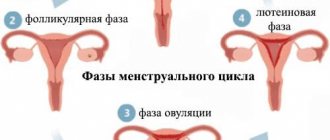Many factors can affect the volume of menstrual blood and cause very weak periods. Body weight, physical activity and stress all cause decreased menstrual flow in different women. Understanding the cause of a problem sometimes allows women to quickly eliminate it.
If women experience periods that seem weaker than usual, in most cases there is no real cause for concern. For many women, the flow of menstrual blood varies—it may be stronger in some months and weaker in others.
In some situations, weak periods may indicate pregnancy or medical conditions closely related to hormonal imbalance. And sometimes women think they are dealing with menstruation, but in fact they have tinted discharge.
In this article, we will discuss how you can identify light periods and when you should see a doctor if you have light menstrual bleeding.
1. Symptoms of weak periods 2. Causes of weak periods 3. Weak periods and contraception 4. Risk factors 5. When should you see a doctor? 6. Conclusion
Symptoms of weak periods
A woman may notice that her menstrual bleeding has become light by the frequency with which she changes pads or tampons.
During menstrual bleeding, on average, about 2-3 tablespoons of blood leaves the body.
However, this amount can vary widely, so women should monitor their periods and notice when they are lighter than usual. The amount of blood released can be measured using menstrual cups.
With light menstruation, women usually experience the following:
- shorter duration of bleeding;
- the need for fewer pads or tampons;
- absence of heavier bleeding in the first one or two days of menstruation (instead, a uniform release of a reduced volume of blood is observed throughout the entire menstruation);
- bleeding, more like minor spotting that occurs for several days in a row.
Light periods can also relieve symptoms of premenstrual syndrome (PMS), such as back pain, uterine cramps, or mood swings.
Instead of menstruation, a drop of blood a day – Mesyachnye.info
The appearance of bleeding in women is a physiological process.
On average, menstruation lasts 3-7 days. During this period, up to 100 ml of blood is released. Experts call this the norm. Many girls may be alarmed by the situation when a drop of blood comes out instead of menstruation. What is this – pathology or normal?
In today's article we will try to understand this issue. Let's find out what a drop of blood means in the middle of the cycle and instead of menstruation.
Drops of blood before menstruation are the first sign of pregnancy. Every woman should know about implantation bleeding. It usually occurs a week before the onset of menstruation or immediately after ovulation.
If a girl has had unprotected sexual intercourse, then the appearance of a few drops of blood on her underwear should alert her. Why does discharge appear?
Let's look at how fertilization occurs:
- The egg leaves the fallopian tube and meets the sperm.
- Fertilization occurs.
- The fertilized egg moves towards the uterus to gain a foothold there. This takes about 46 hours.
- The fertilized egg is “screwed” into the mucosa, which contains many blood vessels. This is why a girl may notice a small amount of blood before her period begins.
In order to confirm or deny pregnancy, the girl is offered to donate blood for hCG.
Other signs of implantation bleeding:
- The girl's basal temperature rises (up to 37.5 degrees).
- Heaviness and pain appear in the chest.
- The discharge is light pink or brown. There can be no scarlet shades.
- A little blood is released (a couple of drops). The discharge ends after a few hours.
Implantation bleeding in women is a normal physiological process. There is no need to worry about this. This is how the body tells you that conception has occurred.
But there are also pathological reasons why menstruation occurs drop by drop per day:
- Sexually transmitted infectious diseases. Among them are chlamydia, trichomoniasis, syphilis, and gonorrhea. With these ailments, the cycle is disrupted, and menstruation may be completely absent. It is imperative that you consult a doctor for treatment.
- Endometriosis. The uterine mucosa grows and thickens, and minor bleeding can occur even in the middle of the cycle. It is necessary to undergo comprehensive treatment to restore the normal state of the endometrium. Doctors often prescribe their patients to take OCs.
- Ectopic pregnancy. The fertilized egg is not implanted in the uterus, but in the fallopian tube. In addition to minor bleeding, the woman experiences pain in the lower abdomen, dizziness, nausea, and fever. It cannot be done without surgical intervention.
- Diseases of the genitourinary system.
It is important! If drops of blood instead of full periods are permanent, you need to contact a gynecologist and undergo a comprehensive examination.
If instead of menstruation there are brown drops on the pad, the reasons may be the following:
- Girl's age.
- Having sex life.
- Pregnancy.
- Lactation.
- Taking oral contraceptives.
- Previous surgery on the organs of the reproductive system.
- Infectious diseases.
- Inflammatory processes of the genitourinary system.
- Neoplasms.
When girls begin menstruation and undergo their first menarche, brown discharge is not a pathology, but the norm. In this way, the ovaries are prepared to perform their functions.
It is not surprising that the cycle can change throughout the year. Sometimes the delay can be up to 50-60 days. There is no reason to worry.
But if such phenomena continue in the future, it is imperative to undergo an ultrasound to rule out polycystic disease and ovarian dysfunction.
Also, small brown drops instead of menstruation can also be observed in women who are in the premenopausal phase. The functions of the ovaries fade away, the amount of blood released decreases.
During pregnancy, the appearance of spotting is a bad sign. There is a high probability of spontaneous miscarriage. The reason for this may be insufficient levels of progesterone in the blood.
If such phenomena are observed, the doctor must send the patient to the hospital, where she is prescribed complete rest and appropriate treatment.
During breastfeeding, mothers experience interruptions in their periods. Minor brown discharge during this period is normal. Don't worry, after lactation ends everything will return to normal.
How should women have their periods? A normal cycle ranges from 21 to 31 days. Deviations upward or downward should alert you.
Ideally, the volume of discharge over the entire period should be about 100 ml. This indicator indicates that the woman has no problems with the reproductive organs.
In the first days, your period may be brown. This is not a pathology. Blood is released in small volumes, so when it comes out of the vagina it has this color.
This may also indicate low levels of progesterone in the blood. It is better to take a hormone test to refute this fact. Otherwise, problems may arise with conceiving and bearing a child.
On other days, the color of the discharge should be red or scarlet. Small burgundy or dark clots are acceptable. Thus, excess endometrium comes out.
On day 6-7, the discharge may change color again. Brown spotting at the end of menstruation is also not considered a pathology.
It is important! In the first days, menstruation may be light, a few drops of blood are released. Often, women need a daily pad. If there are no accompanying symptoms (pain, dizziness, nausea), then this is not a deviation.
There are pathological types of bleeding that a woman may confuse with menstruation. They are as follows:
- Profuse. Often observed in the middle of the cycle. The discharge is profuse and can lead to anemia.
- Juvenile. Very common in women in the premenopausal phase. The discharge is so strong that hemostatic medications may be needed.
- Dysfunctional. It can appear as a result of severe stress, disruption of the pituitary gland and endocrine system.
- Breakthrough bleeding. Spotting occurs in the middle of the cycle. Often associated with taking OCs and installing an IUD.
In addition to pathological types of bleeding, there are also physiological ones that do not require treatment.
These include implantation bleeding. May occur in the middle or end of a cycle. Not accompanied by nagging pain in the lower abdomen.
There are situations when you cannot do without the help of a gynecologist. What signs should alert a woman:
- The nature of menstruation has changed. Instead of copious discharge, only droplets of blood are observed.
- The woman experiences pain in the lower abdomen, dizziness, and body temperature rises.
- The discharge has an unpleasant odor and its color changes.
- Scarlet or black clots appear.
- Bloody discharge occurs in the middle of the cycle. At the same time, the woman does not take oral contraceptives and does not have an IUD installed.
It is important! A small amount of discharge may be due to various factors: experienced stress, intense physical activity, climate change, etc. But if this phenomenon is permanent, it is better to undergo an examination and rule out pathologies.
Experts note that a woman, like no one else, knows the nature of her periods. If something changes, you need to contact a gynecologist. The doctor will suggest you undergo the following types of tests and examinations:
- Inspection on the chair.
- Taking swabs to detect infections.
- Intravaginal ultrasound to exclude diseases of the genitourinary system.
- Blood analysis.
When planning a pregnancy, drops of blood on your underwear should alert you. This may be normal implantation bleeding, which does not pose any threat to the woman’s health.
Also, discharge may indicate a threat of miscarriage. In this case, you need to act quickly enough so as not to lose the fetus.
When only a drop of blood is released instead of menstruation, many women sound the alarm. If the patient had unprotected sexual intercourse, then this is the first sign of pregnancy. In this case, you need to take a blood test for hCG and visit a gynecologist.
A small amount of discharge on the first day of your period is normal. There is no need to worry if the cycle is 21-31 days, there is no pain in the lower abdomen, dizziness, or vomiting.
Source: https://womanmoda24.ru/vydelniya/kaplya-krovi
Causes of weak menstruation
Below are the most common factors that may cause your menstrual bleeding to be lighter than usual.
Age
The strength of the flow of menstrual blood may vary in different years of a woman’s life. At a young age, weak periods are usually observed, which are sometimes manifested by minor bleeding. In your twenties and thirties, periods tend to become more regular.
In the late thirties and early forties, the flow of menstrual blood may increase noticeably. During this time, women sometimes experience periods where one month there is no menstruation, and four weeks later there is heavier bleeding than usual. During perimenopause, periods tend to become lighter and less regular.
Lack of ovulation
Sometimes women suffer from menstrual irregularities due to the fact that the body does not release an egg. This phenomenon in the medical world is commonly called anovulation. Anovulation can cause weak menstrual blood flow.
Lack of weight
Women who are underweight may notice that their periods become very light or stop altogether. This occurs when body fat levels drop to a critical level, causing a woman to fail to ovulate regularly.
Excessive physical activity is another reason for missing periods and can also lead to weight loss.
Pregnancy
A slight discharge of blood in sexually active women may be the first sign of pregnancy.
During pregnancy, women's menstrual bleeding usually stops. However, a woman may mistake so-called implantation bleeding for menstruation, which often occurs when a fertilized egg implants into the wall of the uterus. Implantation bleeding is one of the earliest signs of pregnancy.
If a woman is sexually active and does not observe the usual volume of menstrual flow, then she should use a home pregnancy test.
Medical conditions
Some medical conditions can affect hormone levels in the body. These conditions include thyroid disorders and polycystic ovary syndrome (PCOS), which often affects the menstrual cycle.
Stress
Severe or prolonged stress can affect a woman's hormone levels, causing her menstrual cycles to become less regular.
Reasons for deviation from the norm
Brown discharge before menstruation is too general a concept. In order to understand the reason that caused them, it is necessary to consider this issue in more detail. The nature, color, and amount of discharge can be associated with completely different reasons. So, what are the possible allocation options:
- scanty brown at the beginning of menstruation (on the first day);
- spotting dirty in the middle of the cycle (for the second time in a month, or in a week);
- brown at the end of menstruation;
- dark brown and come instead of menstruation;
- with clots;
- light brown.
Two points out of five are a variant of the norm. We are talking about brown spotting before and after menstruation. Sometimes this happens simply at the beginning of the cycle or due to hormonal changes. There is no doubt that a woman is an overly emotional creature. Due to various types of stress, depression and other unpleasant emotional states, the body can undergo various changes. Initially, all this affects the hormonal background, and therefore the menstrual cycle (then the reasons for dark brown periods are quite understandable). In this case, psychological therapy is enough, or just “waiting it out”; no special treatment is needed here.
It should be noted here that hormonal changes are not always a malfunction within the body; sometimes it is more than a normal natural phenomenon. During puberty, key hormonal changes occur, which can cause your first period to appear brown. A similar situation can occur in women with the onset of menopause.
On the red day of the calendar
The cause of brown spotting after menstruation is almost always simply the end of menstruation.
Important! Many people wonder why blood is brown during menstruation? It is known that due to the iron content, blood oxidizes in air and turns brown. It is important here not to confuse a pathological process with a common occurrence.
When discharge appears in the middle of the cycle against the background of normal menstruation, as a rule, we are talking about some kind of pathological process. The main reasons may be:
- pregnancy (normal or ectopic);
- severe psychological condition, stress, depression;
- inflammatory processes of the reproductive system;
- injuries of the reproductive system;
- a consequence of any medical procedures (for example, abortion);
- malfunctions of the pituitary gland and ovaries.

If you have severe pain in the lower abdomen, you should take painkillers
To understand why brown periods may occur, it is important to understand whether there are additional symptoms such as:
- severe pain in the lower abdomen;
- nausea, vomiting;
- dizziness;
- temperature;
- chills, etc.
In such cases, you should immediately see a doctor to identify the cause.
The endometrium is a mucous tissue, so when it is rejected, it may contain small clots. Your period may come with brown clots. In this case, a large number of clots may indicate the presence of diseases such as:
- high body temperature;
- endometriosis (a disease in which blood clots enter the abdominal cavity through the fallopian tubes);
- endometritis (inflammation due to infection of the uterus);
- pathological growth of the endometrium;
- anemia (lack of hemoglobin);
- ectopic pregnancy.
In all of the above situations, the reasons for dark brown periods were considered. What if your period is brown (light), what does that mean? As a rule, this indicates:
- violation of personal hygiene rules;
- mid-menstrual cycle;
- taking oral contraceptives;
- about taking abortifacient drugs;
- postpartum period.

Changes after taking hormonal drugs
As already noted, the presence of strange “periods” may be associated with taking hormonal medications. Some reviews indicate a side effect in the form of very scanty brown periods. Duphaston is a chemically synthesized progesterone, a real panacea for many diseases, such as:
- endometriosis;
- irregular menstruation;
- infertility;
- possibility of miscarriage due to progesterone deficiency, etc.
When such a side effect occurs, as a rule, the dose of progesterone is simply increased, and spotting bleeding stops. Of course, this must be agreed with your doctor.
Diagnostic measures and treatment
To identify the causes, it is recommended:
- examination by a gynecologist on the chair (including a smear);
- blood test for hCG;
- ultrasound examination of the abdominal cavity;
- MRI and CT (to exclude cancerous tumors);
- thyroid examination.

To eliminate discharge
Of course, the need for certain tests and the above list is determined by the attending physician, based on the examination and the collected medical history. After this, the reason is found out. Well, treatment will already be aimed at eliminating it, since discharge is not a disease, but a symptom.
The gynecologist will inform you about the need for additional tests or examinations if this symptom is not related to the reproductive system. Most likely, you will need to write out a referral to an immunologist, gastroenterologist or other specialized specialists, or undergo additional examinations (take tests).
It is important to monitor your body and listen to different sensations in time. As preventive measures, it should be noted that women lead a healthy lifestyle, which includes not only the absence of bad habits and a healthy diet, but also a healthy emotional state. You should eat more fresh fruits, vegetables, fish, and spend time in the fresh air as often as possible, taking walks. We should not forget that the vast majority of health problems are the result of psychological disorders. For women this is even more serious and significant than for men. That’s why it’s so important to be in a good mood and not get upset over trifles. Then such unpleasant phenomena as unhealthy periods will either not bother you at all, or as rarely as possible.
Signs of cycle disruption
If a woman aged 15 to 40 years has determined that her periods have changed in quantity, she should consult a specialist as soon as possible. Such symptoms indicate a deviation in the functioning of the body.
The main signs in this case include:
- Feeling of pain in the lumbar region, as well as in the chest. In some women, this symptom never appears during the entire period of development of the pathology.
- Painful cramps in the lower abdomen.
- The presence of diarrhea or, conversely, prolonged constipation.
- Frequent headaches, vomiting.
This condition is medically called oligomenorrhea. It leads to infertility in women under the age of forty. Hypomenorrhea can manifest itself as primary symptoms if a girl has never had a normal menstrual cycle, and also secondarily, for example, after bearing a child. If anemic periods occur every month, then this is considered a serious problem that requires the help of a gynecologist.
Scanty periods during pregnancy
Lack of menstruation is the main sign of pregnancy.
But, from the first month, the hormonal background of the expectant mother does not experience significant changes, so there may be scanty discharge, or full menstruation is a variant of the norm.
But in the future, the appearance of spotting during pregnancy may indicate:
- low progesterone;
- increased androgen levels (may be a sign of a threatened miscarriage);
- poor blood flow in the fertilized egg (threat of miscarriage);
- ectopic pregnancy.
How dangerous is the condition?
The condition needs treatment if it is not physiological. Without therapy, there is a high risk of the following complications:
- inability to get pregnant;
- decreased likelihood of fertilization;
- cycle disruption or complete disappearance of menstruation;
- frigidity;
- increased risk of ectopic pregnancy.
To reduce the risk of complications, you should consult a doctor in time to undergo a comprehensive examination. In addition, the influence on the body should be excluded:
- stress;
- poor nutrition;
- bad habits.
The above factors aggravate the situation.
Only treatment and compliance with all recommendations will prevent the development of consequences.
Features of the diagnostic process
During the first appointment, the attending specialist carries out a detailed examination of the patient and collects an anamnesis. The doctor undertakes to find out all the causative factors that could precede menstruation irregularities. For example, these could be occupational conditions or somatic features. It is important to obtain information about whether any pills were taken before this time, as well as about the nature of the woman’s diet. The doctor should also tell you the number of days during which the discharge lasted and when it stopped. If necessary, to identify the exact cause of this condition, special tests are performed:
- cytological examination of the uterine organ for discharge from the genital organs;
- microflora culture of a microbiological nature;
- blood fluid analysis to determine hormonal levels. To do this, the patient undergoes several tests at once, based on the day of menstruation;
- the pelvic organs should undergo a detailed ultrasound examination;
- It is also important to scrape the uterine endometrium.
These factors allow us to determine the exact factors that influence the menstrual cycle and its general condition.
Why periods go poorly: reasons for weak and scanty discharge
You can visit your local obstetrician-gynecologist or go to an appointment with a specialist in a private paid clinic.
Natural (physiological) causes
Physiological and non-health reasons why periods have become scanty or stopped altogether include:
- Completed breastfeeding. The postpartum period is often characterized by long intermenstrual periods and changes in the volume and nature of blood released during this time. The reason for this is hormonal levels, the recovery of which can take quite a long period. The first bleeding is observed in a woman who has given birth and is not breastfeeding immediately after the end of lochia. In a mother who is fully breastfeeding, a cycle may appear only after the complete completion of lactation. For mothers whose children are mixed-fed, menstruation begins 3-4 months after birth. The duration of the nursing cycle can vary from 26 to 40 days, and this is not considered a pathology.
- Pregnancy. Science knows of cases, and there are quite a few of them, when a woman carrying a child does not stop menstruating until she gives birth. However, this is not the usual bleeding, requiring the replacement of 3-4 pads per day. A small amount of bleeding appears on those days that before pregnancy should have been the first days of the cycle. This phenomenon is explained by failures in the production of certain hormones, which often do not require drug correction. Despite this, every pregnant woman, even with the smallest amount of discharge unusual for her condition, needs to consult a doctor to find out the cause of its appearance.
- Taking hormonal contraceptives. Birth control pills, which 1 in 4 women take today, also affect their menstrual cycle. The impact of oral contraceptives on the female body can only be noted on the positive side. With the right pills, women not only do not gain weight, but also lose extra pounds. They restore irregular cycles, reduce the amount of pain and symptoms of PMS, and reduce the volume of blood released.
- Losing weight. Very often, a woman’s body can respond to rapid weight loss by shortening the duration of her periods or by having them disappear altogether for some time. The same phenomenon can be observed in critical obesity.
- Emotional stress. Girls prone to frequent mood swings and depression notice that during periods of strong emotional turmoil, periods do not last long. Overwork and psychological stress inhibit the functions of the ovaries, as a result of which menstruation can be scanty and short-lived (less than 3 days).
The causes of scanty and inconsistent periods (secondary hypomenorrhea) are very diverse. As a rule, they become:
- Sexual infections. Diseases transmitted sexually and domestically are manifested in itching, burning and redness of the external genitalia. They are most often diagnosed in young and sexually active young women. In addition, girls observe an increase in the volume of intermenstrual discharge and a deterioration in their condition. From small, odorless leucorrhoea, they turn into green mucus or foam with an unpleasant odor and purulent impurities. During such illnesses, menstruation either disappears or is very weak. Chlamydia, ureaplasmosis, syphilis, and genital tuberculosis can provoke a decrease in blood volume during menstruation. Chronic cystitis can also damage the integrity of the mucous membranes of the internal genital organs.
- Surgical interventions. Any intervention in the uterine cavity that disrupts the integrity of the endometrium leads to shifts in the monthly cycle. Diagnostic curettage, medical, vacuum or instrumental abortion lead to subsequent delays and various disorders in several subsequent menstruation.
- Ovarian diseases. Various ovarian pathologies, including polycystic disease and andexitis, provoke the release of a small amount of blood during menstruation.
- Immunity problems. A decrease in the duration of menstruation can be observed in women who have a low level of immunity and a lack of vitamins. Thus, hypomenorrhea is very common in endocrinologist patients suffering from iron and hemoglobin deficiency.
- Incorrect development. Anomalies in the structure and development of the internal and external genital organs also affect how menstruation occurs.
- Neoplasms. The presence of benign and malignant tumors in the uterine cavity and ovaries causes disruptions in the menstrual cycle.
Treatment
Since the nature of the appearance of hypomenorrhea can be very diverse, treatment is carried out symptomatically:
- for hormonal imbalances, this is treatment with hormonal drugs;
- for inflammations of various types - complex treatment with antibiotics.
The only general indications are:
- refusal of strict diets;
- rejection of bad habits;
- psychotherapy (if the disease is caused by a psychoemotional disorder).
Drug treatment
Drugs are selected solely based on the diagnosis itself. But there is a small list of medications that are used in almost every case:
- Duphaston;
- Qi-Clim;
- Estrovel;
- Remens.
Surgery
Surgery is necessary if the cause is:
- synechia (sticking together of the labia minora);
- cancerous tumors;
- benign tumors.
When is treatment required?
To determine the cause, it is necessary to undergo an examination. Based on its results, the doctor will decide on treatment.
The choice of therapy is determined by the reason for the large blood volume:
- In case of hormonal imbalance, oral combined contraceptives containing estrogen and progesterone are prescribed. They stop the growth of the endometrium, which reduces the number of periods.
- In inflammatory diseases, the goal of therapy is to eliminate the pathological process and restore the normal functioning of the organs of the reproductive system.
- For benign formations - polyps, fibroids - medications are first prescribed, for advanced forms of the disease - surgical intervention.
- After childbirth, anti-inflammatory medications, vitamins, immunotherapy are prescribed - everything that will help the body recover.
All medications are prescribed only by a doctor; self-medication is unacceptable, as it can lead to negative consequences.
We recommend reading the article about the causes of frequent periods. From it you will learn about the factors causing the failure, the causes of frequent menstruation in adolescents, women over 45 years old, and possible diseases.
Why do my periods last 2 days? Read here.
How to treat hypomenorrhea
The treatment regimen for the pathology will depend on the cause that provoked the appearance of scanty menstruation. Treatment of hypomenorrhea caused by gynecological diseases is carried out by a gynecologist. If the disease is caused by endocrine disorders, treatment is carried out by a gynecologist-endocrinologist. For psychological dysfunctions, hypomenorrhea therapy is carried out by a psychologist and a gynecologist (if necessary, a psychiatrist). Therapy for scanty menstruation caused by tuberculosis infection is carried out by a phthisiatrician.
Considering the causes and severity of the pathological condition, treatment of hypomenorrhea can be carried out using conservative and surgical methods. Conservative therapy includes taking antibacterial, anti-inflammatory, hormonal, absorbable medications and physiotherapy. If there is a lack or excess of body weight, its correction is carried out. Vitamin complexes are prescribed according to the phases of the menstrual cycle.
Surgical treatment of hypomenorrhea is aimed at dissecting intrauterine adhesions by hysteroscopy.
Hypomenorrhea: why are periods weak?
For every woman, a regular menstrual cycle is, first of all, an indicator of health. Normal periods without deviations include those that occur regularly, their abundance, character, intensity and duration are unchanged from month to month. But in practice everything is a little different. Most women face menstrual problems.
Why are my periods bad? A question that concerns almost every third representative of the fairer sex.
Why do you have scanty periods: possible reasons
If your periods are bad and there is very little blood being released, you should find out the reason. Deviations from the norm, when the amount of blood released per day is less than 50 ml, may indicate diseases of the reproductive system.
Every woman should keep a calendar, where to mark the days, mark the nature and intensity of her periods. To find out the exact reason why your periods are not going well, you need to visit a gynecologist. These indicators will help the doctor make a conclusion.
If your periods are scanty (spotting), then experts make a diagnosis of hypomenorrhea. The main reason for such menstruation is an imbalance associated with the functioning of the ovaries or pituitary gland. These organs are important in the formation and regulation of the normal menstrual cycle.
Hypomenorrhea is accompanied by scanty discharge when, during menstruation, a woman loses insufficient blood. Simply put, the volume is less than the physiological norm.
The norm is when a woman loses from 50 to 150 ml of blood. Weak periods can be caused by physiological factors.
During hypomenorrhea, menstruation appears as spotting or drops of blood, which can be dark brown or light in color. In the future, with such scanty menstruation, they may be shortened in duration or absent altogether.
Why do you have scanty periods - reasons:
- Malfunction of the ovaries. The cause of dysfunction can be various inflammatory diseases, hormonal imbalances, and external factors. Diseases such as oophoritis, salpingo-oophoritis, tuberculosis of the genital organs - these diseases are considered the main causes that can cause scanty periods.
- Heredity. Sometimes, at the genetic level, scanty discharge is passed down the family line. For example, if relatives had bad periods and this was considered within the normal range, without affecting conception. In this case, this is not a pathology.
- Diseases and congenital pathologies of the uterus . Weak discharge may also indicate that there is inflammation of the uterus or appendages. Hypomenorrhea can also be caused by: adhesions, scars, taking hormonal contraceptives, and diagnostic manipulations in the uterine cavity. Sometimes the cause is tumors of various types in the appendages, cervix and in the uterus itself.
- Hormonal changes. Failures can occur while taking contraceptives or due to a lack of some sex hormones in the body. But scanty periods can also cause other hormonal problems: diabetes during lactation (prolactin levels increase), problems with the endocrine system, when the thyroid gland produces few necessary hormones.
- Psycho-emotional state. The emotional state affects the entire body, including the reproductive system. Any positive and negative emotions affect the brain, and it transmits a signal to the ovaries, so it can adversely affect their work.
- Other reasons: excessive physical activity, intoxication of the body, overwork, fasting, sudden weight loss, anorexia, injury, lack of essential vitamins, radiation, exposure to chemically harmful substances, acclimatization and infectious gynecological diseases.
Weak menstruation: what treatment is used?
To prevent scanty discharge and not wonder why your periods are not going well, you need to visit a gynecologist on time. The specialist will prescribe all the necessary laboratory and medical examinations and tell you about preventive measures.
It is unlikely that you will be able to determine the cause on your own, so it is better not to risk it. A qualified gynecologist will be able to answer the question of why deviations from the norm occurred. If necessary, you may need the help of an endocrinologist.
Also don’t forget that you need:
- Healthy food;
- lead a healthy lifestyle;
- exercise;
- try to avoid stress.
You need to visit an obstetrician-gynecologist at least once every six months to monitor the condition of your body, especially the condition of the reproductive organs.
There is no standard treatment regimen for hypomenorrhea. Each course is compiled after a complete transcript of the results of all examinations.
As a rule, if dysfunction in the genital organs is caused by poor nutrition, psycho-emotional state, etc., then vitamin complexes together with hormonal agents and drugs with antimicrobial properties are prescribed.
When menstruation is short, homeopathic medications have a good effect in treating scanty discharge.
Sometimes during treatment a woman experiences:
- depression, stress;
- lethargy, apathy;
- frigidity.
In such a situation, sessions with a visit to a psychotherapist are added to the course of therapy.
Complementary and alternative treatments at home
There are several other alternative treatments for hypomenorrhea, but before you try them, you should consult with your doctor.
Nutrition and supplements
When fighting hypomenorrhea, it is important to maintain proper nutrition, because often the cause of scanty discharge during menstruation is precisely hunger strikes and strict diets. General treatment also includes taking complex vitamin preparations.
Traditional medicine recipes
Treatment with folk remedies is also widespread, such as:
1. Decoction of onion peels:
- 200 gr. Onion peel;
- 0.5 liters of boiling water.
Leave to cool for 20 minutes. Take 2 times a day, half a cup
2. Quinoa tincture:
- 20 gr. Quinoa;
- 50 ml. Boiling water.
Leave until it boils. Take a cup 3 times a day.
3. Oregano tincture:
- 100 gr. Oregano;
- 20 ml. Vodka.
Leave for 3 weeks. Shake occasionally. Strain and drink 3 times a day, 30 drops.
4. Verbena decoction:
- 25 gr. Verbena;
- 500 ml. boiling water
Insist for a day. Drink during the day.
5. A decoction of St. John’s wort grains and thorn flowers:
- 40 gr. St. John's wort and thorn flowers;
- 500 ml. Boiling water.
Menstruation without blood
There are various manifestations of hypomenstrual syndrome, which are characterized by varying duration and intensity of uterine menstrual flow.
Is it possible to have periods without blood? Undoubtedly, on the Internet you can find a huge number of questions on forums from women suffering from this phenomenon. They all present the same complaints - that on the days of the expected menstruation, discharge of a sanguineous nature appears, that is, transparent discharge with a pink tint, but the discharge of full blood does not occur.
This is one of the types of hypomenorrhea, which is characterized by very scanty discharge due to the virtual absence of a functional endometrial layer. This is considered a pathological condition and requires timely and comprehensive diagnosis by obstetricians and gynecologists. However, it is worth remembering that such a condition can also be completely physiological.
Traditional medicine for scanty menstruation
It is not always necessary to treat a decrease in menstrual flow with medications. For example, in case of sudden weight loss, the doctor will simply recommend that the patient balance her diet.
A woman’s health and her hormonal levels depend on proper nutrition. The diet should include foods that are saturated with all necessary and beneficial substances. Protein can be found in legumes, meat or fish. Vegetable oils will saturate the body with fat, and cereals will saturate the body with complex carbohydrates. Vitamins and antioxidants can be obtained by eating fresh fruit every day.
Since stress is the main source of hypomenorrhea, it is necessary to combat it. If you can’t do it yourself, it is recommended to contact a specialist for help. After treatment, the emotional and psychological state improves, the reproductive system is restored and, as a result, the duration of menstruation is normalized.
Physiotherapy, such as restorative massage or mineral baths, can also be used as treatment. In addition, a decoction of carrot seeds or freshly squeezed aloe juice is used. Drink a decoction or juice several times a day, two tablespoons. You can also take medicines made from saffron. To do this, add a couple of pinches of saffron to a glass of warm milk and drink.
- Etiology
- Classification
- Symptoms
- Diagnostics
- Treatment
- Possible complications
- Prevention and prognosis
The causes of the disorder do not always have a pathological basis. The trigger may be adherence to an overly strict diet, a change in time zone or climate, or an overdose of medications.
The symptoms are quite specific - menstrual flow is light or dark brown. Headaches and problems with bowel movements occur. Often women complain that their chest hurts and cramping pain appears in the abdomen.
Diagnostics is aimed at identifying a predisposing factor; a wide range of laboratory tests and instrumental procedures may be required.
Treatment of hypomenorrhea is prepared individually for each patient - the tactics are dictated by the root cause. Clinicians often turn to conservative methods.
Scanty discharge and external factors
The female body, especially the part of it that is responsible for reproduction, is a very sensitive area, subject to the influence of many circumstances. This is due to the important participation of hormones throughout the menstrual cycle. They are produced by several organs that can be affected by:
- Hard physical labor. A strong load that is not typical for the female body interferes with the production of hormones that cause ovulation and increases the concentration of others. If he is almost constantly subjected to such tests, even such a phenomenon as menstruation without blood may occur. By a certain time, there are all the signs of menstruation: nagging pain in the lower triangle of the abdomen, breast swelling, drowsiness or irritability. At the same time, the discharge does not have the color and thickness characteristic of critical days;
- Stress. It can be caused by personal reasons or a sudden change in climate when moving or time zones. Even if a woman does not experience suffering due to changes in her life, the body cannot be deceived. The center of the brain responsible for emotions suppresses the work of the ovaries, whether it is due to negative life events or happy ones. They reduce the production of estrogen, which causes a decrease in the intensity of menstrual flow;
- Hunger. If it is not present in the literal meaning of the word, but a sudden and shocking change in diet occurs for the body, this is reflected in the abundance of menstruation. An exhausted body saves energy, which affects the reproduction of hormones. As a result, periods have become less abundant.
Causes
Most often, scanty periods are not a serious condition, but it is important to diagnose the underlying cause to avoid future complications.
The causes of scanty discharge during menstruation can be:
- anorexia nervosa or bulimia;
- obesity;
- avitaminosis;
- anemia;
- thyroid diseases;
- a consequence of abortion or curettage;
- congenital anomaly of the uterus;
- consequences of operations in the pelvic area;
- a sharp increase in psycho-emotional stress;
- excessive physical activity;
- tuberculosis of the genital organs;
- period of pregnancy and lactation;
- the period before the onset of menopause;
- STD;
- radioactive and chemical exposure;
- inflammatory processes in the uterus;
- first menstruation during adolescence.
Sometimes the main causes of this unpleasant condition may simply be vitamin deficiency, anemia, or it may be caused by emotional or psychological trauma.
A life-changing event, a stressful period of life or loss, or just one major shock in a woman's life is enough for her menstrual cycle to be disrupted for some time.
Common causes of menstrual irregularities
They can be associated with several situations. These are disturbances in the functioning of the endocrine glands, inflammatory processes, as well as severe situations associated with adverse effects on the body.
Surgical interventions
This is one of the reasons why dark periods appear.
The reason in most cases will depend on the type and nature of the manipulation performed:
- In some cases, the appearance of brown periods may be due to a reaction to the insertion of an intrauterine device. In this case, there may be a manifestation associated with trauma to the mucous membrane of the uterine cavity, or its reaction to the appearance of a foreign body. As a rule, subsequent menstruation is no different from the previous one.
- For endometriosis, an intrauterine system with levonorgestrel can be used , which, during its presence, begins to release a certain dose of the hormone, which leads to the development of short-term tissue addiction.
- Also, brown periods can be associated with surgical interventions such as curettage of the uterine cavity. In some cases, it can be performed for diagnostic purposes, as well as to prevent pregnancy. Similar menstruation appears immediately after the procedure; the brown color can persist for a week with a gradual decrease in intensity.
- In addition, strange brown periods may be a consequence of interference in the uterine cavity associated with previous pathology.
Symptoms of scanty periods
Little discharge during menstruation is the main symptom of hypomenorrhea. In this case, the cycle duration may remain the same or be reduced. In addition, other symptoms that accompany scanty discharge may occur:
- headaches and dizziness;
- nausea;
- unpleasant pain in the chest;
- pain in the lower back and lower abdomen;
- nosebleeds;
- weakness;
- constipation or diarrhea;
- decreased libido (occurs as a result of decreased estrogen levels).
The discharge will be spotty in nature, as a rule, it is brown or brown in color. A decrease in the amount of discharge is not always accompanied by additional symptoms. Therefore, it is important to immediately consult a doctor if such a phenomenon occurs.
Causes of discharge in the absence of sexual activity
In this case, the presence of brown discharge, which is a complication of pregnancy, should be excluded, and the risk of developing an inflammatory process should also be reduced. But at the same time, there are various kinds of hormonal causes, nutritional factors and severe gynecological diseases.
Among the diseases, internal endometriosis should be noted. This is a condition characterized by the discharge of menstruation, which is brown in color.
With the development of endometriosis, the mucous membrane of the uterine cavity spreads beyond its anatomical area, so the endometrium can be located in the muscle layer and other organs and systems.
These are also stressful situations and lifestyle changes that can lead to hormonal imbalance.
Weak periods and contraception
When women start taking birth control pills, they may find that their periods become increasingly lighter.
The decrease in the strength of menstrual blood flow occurs due to the fact that the hormones contained in oral contraceptives do not stimulate the uterus to grow the mucous membrane or endometrium. As a result, women experience weak periods, because the uterus rejects a minimal amount of endometrial tissue.
Birth control pills may cause weaker periods
All this can be observed not only while taking birth control pills, but also when using intrauterine devices (IUDs), contraceptive implants or injections. Each of these remedies leads to thinning of the uterine mucosa.
Women may also experience breakthrough bleeding in the first months of using hormonal contraception, as hormones begin to regulate the menstrual cycle.
Sometimes doctors recommend that women with weak periods take birth control pills to restore a normal menstrual cycle. Some types of oral contraceptives contain hormones that help stabilize your cycle.
Drug treatment of pathology
If the volume of discharge has decreased and your periods are less than usual without objective reasons, you should visit a gynecologist. After the examination, the doctor will prescribe a series of laboratory tests for the woman. Based on their results, it will be possible to determine the cause of the menstrual cycle disruption and select adequate treatment methods. You will need to undergo an ultrasound of the uterus and ovaries.
If the examination reveals disturbances in the functioning of the endocrine glands, the woman is prescribed hormonal therapy. This treatment is designed to normalize the functioning of the ovaries and regulate the menstrual cycle. Gradually, the amount of blood during menstruation should stabilize.
Gynecologists usually prescribe estrogen or progestin. The choice of drug depends on the concentration of sex hormones in the woman’s blood. The duration of the course is 3–6 months.
In some cases, hormonal contraceptives, selected taking into account the individual characteristics of the woman, help restore the normal menstrual cycle.
Doctors often give preference to drugs of natural origin that can stabilize hormonal levels. The drugs Qi-Klim and Estrovel have good reviews.
If a woman regularly experiences scanty menstruation, then it is necessary to take vitamins to maintain the health of the whole body at a high level.
When the volume of menstrual blood decreases due to the presence of infection in the body, it is necessary to treat the provoking factor itself. In some cases, antibiotics or agents with anti-inflammatory effects may be prescribed.
If menstruation is accompanied by severe pain, the doctor will recommend taking analgesics. You can use drugs such as Bral, Baralgin, Analgin, Spazmalgon. No-shpa or Papaverine relieve spasms well.

Estrovel is often prescribed for scanty periods.
Risk factors
In the absence of risk factors for the development of weak menstruation, this symptom may also occur. However, it is more likely to be observed in women who are associated with such factors.
Risk factors include the following.
- Age. Young women tend to have light periods.
- Breast-feeding. This is a natural process that can cause a complete absence of periods or light menstrual bleeding when the cycles are just starting to return after childbirth.
- Stress. Severe stress may not affect the level of hormones in a woman’s body.
- Polycystic ovary syndrome. Some diseases affecting the reproductive system can affect the strength of menstrual bleeding. Such diseases include polycystic ovary syndrome.
Women can talk to their doctor about individual risk factors that affect the amount of blood they release during their periods.
Hypomenorrhea in various diseases
Quite often, scanty menstruation is a symptom of a more serious disease than a simple cycle failure. These may be disorders in the reproductive sphere or ailments associated with other organs.
Malfunctions of the ovaries
The ovaries and pituitary gland are one of the main organs that regulate the menstrual cycle. Therefore, the most common and serious causes of violations in this area are dysfunctions. They can be provoked by many factors:
- Diseases of the reproductive organs. These are adnexitis, oophoritis, venereal infections. They, in turn, arise due to neglect of hygiene, hypothermia, frequent and improper douching, carelessness in intimate relationships;
- Nervous stress, physical and psychological fatigue caused by chronic non-compliance with normal work and rest schedules;
- Abortions and miscarriages. If this happened during your first pregnancy, you shouldn’t be surprised why your periods became scanty. The sharp hormonal changes caused by these events can have such a negative impact on health that a woman will have to undergo long-term treatment for infertility;
- Improper development of female organs;
- Long-term use of hormonal contraceptive pills or incorrectly selected means;
- Endocrine disorders.
With various kinds of dysfunctions, there are no conditions for the maturation of the egg. Consequently, menstruation cannot be full. The volume of discharge is usually minimal.
Diseases of the uterus and its parts
As you know, the lion's share of menstrual flow consists of the cells of the endometrium lining the uterus from the inside. Therefore, their scarcity can be directly related to:
- Ectopic pregnancy. A woman notices that her periods are coming, but they are not coming on time. If with this sign she feels swelling of the mammary glands, nausea, perhaps the fertilized egg is not where it is needed;
- Consequences of operations on the uterus (partial removal, treatment of fibroids, delivery by cesarean section). We are talking about the adhesive process, which inevitably leads to a decrease in the size of the endometrium, and therefore reduces the intensity of discharge;
- Erosion of the cervix. The disease reveals itself by spotting, which can appear outside of menstruation, as well as pain during vaginal contact;
- Inferiority of the endometrium. The causes may be tumor diseases, their treatment with heavy antibiotics and chemotherapy, cell atrophy due to hormonal contraception. One of the symptoms of the chronic form of endometritis is very scanty periods, which are complemented by elevated temperature and constant putrefactive discharge. The first of these signs is also characteristic of endometriosis, in which menstrual periods begin with long-lasting spotting. They are also quite painful.
Tuberculosis of female organs
This is a fairly rare and also infrequently identified reason why a woman has weak periods. Everyone has a rough idea of what Koch's bacillus is in the lungs. But ignorant people do not know that it can settle and develop in the reproductive organs. It is quite difficult to identify the disease in an adult woman, since its symptoms are not pronounced. If it has been present since adolescence, girls may have underdevelopment of the mammary glands, there may be abnormalities in the structure of the uterus, and obstruction of the fallopian tubes. But in young and not so young people, tuberculosis of the genital organs causes persistent infertility, as it is accompanied by a complete absence of menstruation or scanty discharge. The disease can also occur after childbirth and manifest itself violently, with high fever and severe course. Another variant of tuberculosis with intermittent exacerbations and remissions, the symptoms of which are similar to inflammation of the uterine appendages. The woman and her gynecologist may not suspect the true cause of the ailment; fluorographic or x-ray examination does not show anything.
Hormonal disorders
Hormones are the direct participants in everything that happens during the cycle. A deficiency of some and an excess of others can cause menstruation to be smaller in volume. This is inevitable when:
- Diseases of the thyroid gland. The organ produces hormones, and if anything interferes with this, not only the endocrine system suffers;
- Diabetes mellitus. As it progresses, reproductive function fades faster than in women with a normal level of glucose in the blood. At the same time, the cervix begins to produce more discharge than usual. The woman notes that there is little blood in her periods, and they have acquired a lighter color than before.
When should you see a doctor?
Weak periods usually do not indicate serious health problems, but if a woman experiences this symptom regularly or does not notice her periods at all, then she needs to see a doctor.
In addition, you should go to the hospital if, along with weak menstruation, other alarming symptoms occur, such as pain in the pelvic area.
In most cases, weak periods do not indicate dangerous medical conditions.
A number of factors can lead to the appearance of this symptom, such as diet, physical activity, hormonal contraception, or diseases of the reproductive system.
It is important for every woman to listen to her body and thus monitor the processes that occur in it. If you are concerned about the duration or severity of menstrual bleeding, it is better to consult a doctor who will help dispel doubts or conduct a comprehensive medical examination.
Hypomenorrhea
A frequent cycle disorder is hypomenorrhea, or scanty periods, when blood discharge becomes weak. It is most often accompanied by another pathology - oligomenorrhea, when menstruation lasts fewer days than usual, the duration of bleeding during menstruation is noticeably reduced. Menstruation is considered scanty if the blood loss during all days of menstruation is no more than 50 ml.
For scanty menstruation:
- change color: either too light or dark, brown in the form of strokes;
- can last the usual number of days, but more often they last a shorter period, 1-2 days.
Hypomenorrhea is most often caused by some disease; there are many reasons for scanty periods, and most of them require therapy, since they provoke dysfunction of the reproductive organs and other systems in the body.
Reason No. 1: Underweight and overweight
One category of women carefully looks after themselves and tries to stay in shape. Diets, exercises in fitness centers, gyms and swimming pools are used. The flow of physical activity on an organism exhausted by diets forces it to save energy on everything, including the production of hormones. As a result, menstruation lasts for few days, and they are very scanty. This is a kind of body response to shock from exercise and changes in diet.
Experts have proven that the menstrual cycle and muscle mass in women are connected: muscular representatives of the fair sex often experience scanty periods.
The reason that little blood is released during menstruation and that they have become very short may be excess weight. This is a different category of women - those who are accustomed to eating improperly or who are prone to excess weight due to any concomitant diseases. Fat tissue accumulates estrogen, which disrupts the cycle, leading to scanty menstruation: they become weak, in the form of rare spotting.
Reason #2: Polycystic and other ovarian diseases
One of the most common reasons why little blood is released during menstruation is disturbances in the functioning of the ovaries. It is quite easy to establish this etiology using a blood test, including determining the level of hormones secreted by the body. Typically, the doctor checks the amount of thyroid hormone, insulin, estrogen, androgens, and progesterone. Based on the results, the specialist will determine the likelihood that the woman has a disease such as polycystic ovary syndrome, which is characterized by irregular and scanty periods.
To accurately establish the diagnosis, it is necessary to conduct an ultrasound, which will determine the size of each ovary, the thickness of the endometrium, the condition of the follicles and the presence of their growth, the presence or absence of ovulation, and other pathologies of the reproductive organs caused by disturbances in the functioning of the thyroid gland. If this pathology is not diagnosed in time, the disease can lead to infertility.
With polycystic disease and other hormonal imbalances, in addition to scanty periods, increased oily skin and acne, excess body hair, and weight gain are observed.
This same group of reasons that cause changes in the amount of blood released during menstruation includes disturbances in the functioning of the pituitary gland.
Reason #3: Tuberculosis and other infections
Another very serious reason why menstruation became scanty and began to last several days less is tuberculosis, which affected the patient’s genitals. In addition, other infectious diseases and inflammatory processes in the body, especially in the genitourinary system, can affect the menstrual cycle and significantly harm it. They entail inferiority of the uterine mucosa, which leads to scanty menstruation. Therefore, if a woman notices scanty discharge instead of menstruation, it is important to consult a doctor in order to diagnose such diseases and receive timely treatment.
Reason #4: Abortions and other surgeries
Scanty discharge once a month can be caused by problems with the ovaries. Frequent abortions can easily provoke their improper functioning, since they wreak havoc on the production of hormones in the body, interfering with proper blood circulation in the uterus. Curettage to terminate a pregnancy injures this organ, which also disrupts the menstrual cycle and leads to scanty periods.
The functioning of the reproductive system can also be damaged after other surgical procedures: after operations to remove polyps and fibroids, the quality of the endometrium changes significantly and for the worse; it is damaged, which affects the quantitative and qualitative characteristics of menstruation.
Reason #5: Gynecological diseases
When scanty periods appear, it is imperative to pay attention to the condition of the body, since they can be symptoms of other gynecological pathologies that require treatment and sometimes surgical intervention: these are diseases of the pelvic organs, the formation of polyps or fibroids in the uterus, the development of diseases transmitted through sexual contact .
Reason No. 6: Harmful and hard work
Hypomenorrhea can also occur in completely healthy women whose work involves:
- with heavy physical labor, heavy loads;
- with toxic, harmful substances;
- with radioactive radiation or chemicals.
These working conditions interfere with the proper functioning of the hormonal system to such an extent that they can prevent the onset of ovulation, increasing the concentration of hormones in the body that interfere with the proper functioning of the reproductive organs. This leads to scanty and short periods.
Reason #7: Incipient miscarriage
A woman may not know that she is pregnant, so the onset of menstruation will not alert her, but the arrival of scanty menstruation should be a signal of alarm: small spotting during pregnancy, which can be confused with menstruation, is a symptom of spontaneous abortion, placental abruption , which is very dangerous for the fetus. Such bleeding is an indication for urgent hospitalization of a woman for pregnancy-preserving therapy.
Reason #8: Nervous condition
Frequent stress and being under constant tension can easily cause hypomenorrhea, because such conditions overwork the body and deplete its strength. Other diseases of the nervous system can also cause scanty periods.
Mental trauma, strong emotional experiences and disorders affect the quantitative characteristics of menstruation. Climate changes and prolonged severe pain, which affect the general condition of the body, lead to scanty periods.
Similar article - How to properly brew oats to cleanse the liver
Reason #9: Drugs
Scanty periods appear in women who have chosen the wrong hormonal medications, for example, contraceptives, which should only be done with a doctor. Taking any contraceptives entails a decrease in bleeding during menstruation.
Light menstrual bleeding lasting 1-2 days with scant discharge Light red color of early blood Occasionally a "muddy" type of blood with brownish-black discharge
The main biological cause of scanty menstruation (hypomenstrual syndrome) is insufficient development of the mucous membrane of the uterus and ovaries. Birth control pills also often lead to a significant reduction in monthly bleeding. Psychologically, this reason is due to a violation of the relationship between menstruation and a woman’s life, as well as possible deviations in her perception of her nature and attitude towards the natural processes of menstruation.
In girls who have not yet formed and developed a regular cycle, weak first bleeding is not a cause for concern. In women aged 40 to 50, weak menstruation may be a sign of the onset of menopause.
Not all girls and women are able to identify with their monthly cycles and regular bleeding. Some people in our society still often associate menstruation with dirt and impurity, as a symbol of the fact that one should not expect offspring in the near future and there is no need to fulfill the “biological duty” of becoming a mother. For some impressionable women, this assessment does not remain without psychosomatic implications. Many menstruation passes so quickly and with a minimum amount of discharge because it is easier for suffering women to endure it; they subconsciously “rush” their menstruation in order to hide it and quickly get rid of the obsessive feeling of uncleanness of their own body.
Old and reliable - help yourself!
Acupressure You can strengthen the mucus from the lining of the uterus using an acupressure point located on the outside of the base of the nails of the big toes. At their tips there is an acupressure point, with the help of which you can stabilize the functioning of the pituitary glands of the brain and thereby regulate your menstruation. Massage both points in a circular motion 3 times a day for 3 minutes - each finger.
Aromatherapy From aromas, choose first of all marjoram and juniper, they regulate the release of hormones by the body. Place a few drops of your chosen essential oil into an aroma lamp or a cup of water and place it in your bedroom.
Foot baths with increasing water temperature They act as a stimulant and promote increased menstruation. Fill the foot bath with warm water (about 33°C) and place your feet in it. Then add hot water little by little until the water in the bath reaches a temperature of 42 °C. Add water in small portions over a period of about 15 minutes. Finally, dry your feet well and dry them with a towel! Start these baths daily 8 days before the expected start of menstruation.
Prevent illness and stay healthy
Move more in the fresh air, but without heavy sports activity! Strength sports lead to serious disruption of menstrual cycles and weakening of monthly bleeding. Studying the performance of female athletes involved in strength sports proves that cycles depend on a certain amount of fat in the body. If the body consists almost entirely of muscles, menstruation may even disappear completely. Avoid stress! Severe stress and other stress on the body lead to fluctuations in the release of hormones, which can affect menstruation. Learn relaxation techniques to better cope with stress.
Menstruation (menstruation) is a cyclical process in a woman’s body, the so-called genital bleeding. The main function of the female body is reproductive function. In a woman’s body, an egg matures (ovulation), it leaves the ovary and travels through the fallopian tubes to the uterus. In turn, the uterus prepares to meet the egg: the endometrium matures, the thickness of the endometrium increases, the corpus luteum is formed, specific female hormones are produced, the secretory activity of the endometrial glands is prepared for the acceptance (implantation) of a fertilized egg (embryo). If an unfertilized egg enters the uterus, then implantation does not occur, the corpus luteum dies within about 14 days, the vessels narrow, and the dead endometrium is rejected. Then everything is removed from the body, this is actually called menstruation (menstruation).
Each woman's menstrual cycle has its own duration.
Menstruation occurs individually for everyone, but during the premenstrual period the same processes occur:
- The appearance of pain;
- Enlargement and tenderness of the mammary glands;
- Changes in the state of the nervous system, etc.
Often girls and women complain that all the signs of approaching menstruation are there, but the menstruation itself has not started. Is it possible to have periods without blood?
If all the signs of premenstrual syndrome are present, but there are no periods, then there may be a lot of reasons for this. Irregular periods may be due to lack of ovulation or disturbances in the process of egg maturation; pregnancy; early menopause; breastfeeding; hormonal imbalance in the body; sudden weight loss as a result of a complex diet (for example, a raw food diet); diseases of the ovaries (polycystic disease); diseases of the endocrine system; colds (flu); stress, depression, overwork, moving.
That is, it is now clear that menstruation without blood is the absence of menstruation, the so-called amenorrhea.
There are several types of amenorrhea:
- Physiological amenorrhea
is a natural process that occurs during pregnancy, breastfeeding, age-related menopause, and the absence of menstruation in childhood. This is not a disease. - False amenorrhea
- hormonal changes occur in the body in their own order, but there are mechanical obstacles to the release of blood. - True amenorrhea
is a violation of the cyclicity of hormonal changes, absence of ovulation, pregnancy is impossible. - Pathological amenorrhea
is a symptom of serious diseases of the reproductive system in a woman’s body.
Having periods without blood is not normal. Be sure to see a gynecologist to find out the cause of amenorrhea.
The presence of a stable menstrual cycle in a woman indicates that her body is capable of conceiving and bearing a child. Any failures and deviations in duration, too intense pain, changes in the color and amount of menstrual flow indicate the presence of certain pathologies that need to be eliminated as soon as possible.
One of the most common complaints with which girls turn to gynecologists is weak menstruation. Just like too much, scanty menstrual flow is a symptom of a disease that threatens not only future motherhood, but also the life of a woman as a whole. Let's find out why this pathology develops.
When to see a doctor
Any manifestation of a deviation from the norm may be a reason to visit a doctor, who is able to determine the cause based on the following points:
- interview and examination of the patient;
- bacteriological culture;
- Ultrasound;
- determination of hormone concentrations;
- biopsy;
- measuring basal temperature during the menstrual cycle.
You should consult a specialized doctor if there is a sharp reduction in bleeding in a woman of childbearing age. In this case, the doctor will be able to determine the underlying cause and prescribe the correct treatment. Also, a woman who has stopped breastfeeding and her menstrual cycle has not returned should not put off going to the doctor.
Diseases of the endocrine system and thyroid gland also require consultation with a doctor. It should be remembered that the endocrine system will be brought back to normal by the absence of stress in life and the presence of positive and pleasant emotions.
Diagnostic methods
Diagnosis of hypomenorrhea necessarily includes:
- Gynecological examination. The patient undergoes an external and internal examination and answers the doctor’s questions necessary to collect an anamnesis.
- Examination to identify predisposition to cancer. Diagnosis of cervical cancer includes a Schiller test, a cytological smear, and colposcopy.
- Flora smear. Determines whether pathogenic organisms are present in the vaginal microflora.
- Diagnosis of STDs. PCR diagnostics involves taking smears, scrapings and the patient’s blood to detect sexually transmitted infections.
- Urine and blood analysis. Detailed blood and urine tests help determine the presence of foci of inflammation. Blood biochemistry shows the content of sex hormones necessary for the normal functioning of female organs.
- Ultrasound. An ultrasound examination of the uterus and ovaries shows how the organs visually look and whether tumors are present.
- Consultations with other doctors. Sometimes the gynecologist may refer the patient to see another highly specialized specialist - an endocrinologist, phthisiatrician, surgeon or oncologist.









